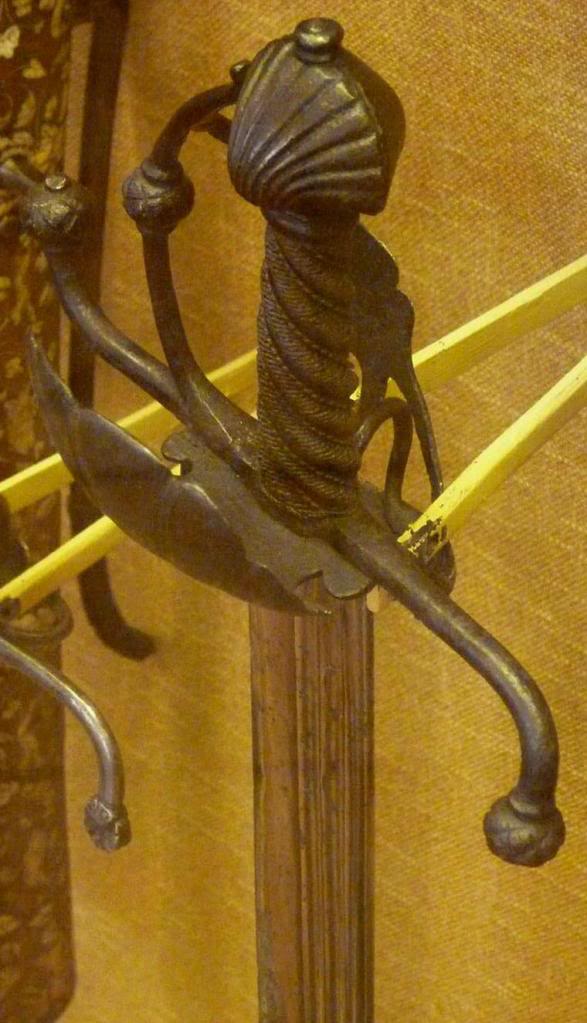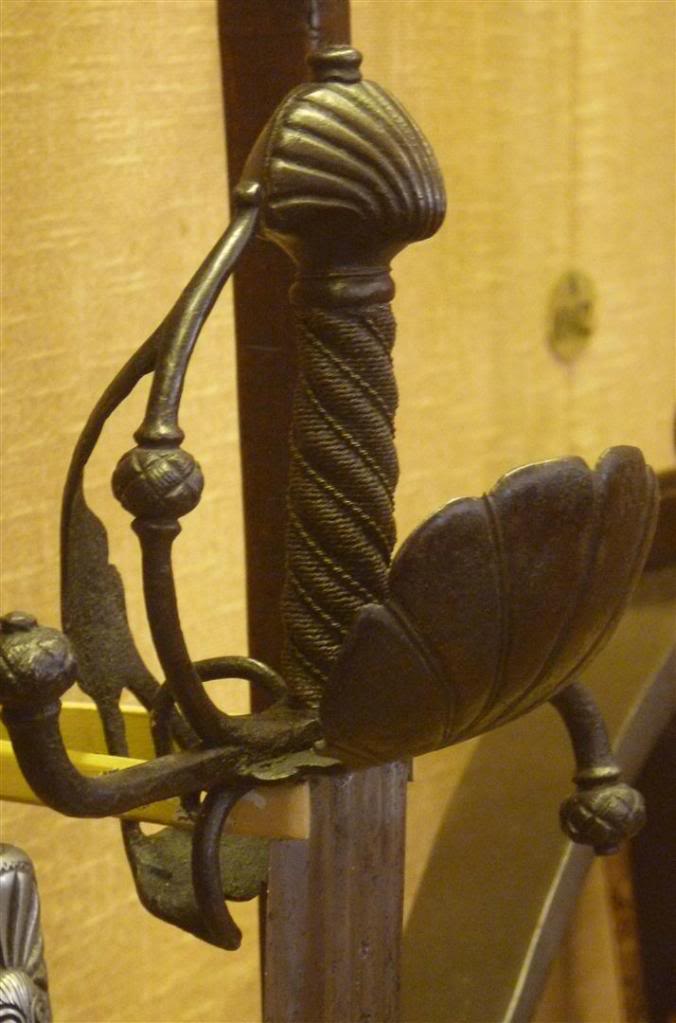I have a question about the Wallece collection dussack and similar Sinclair hilts that has been bugging me for some time now. What I want to know is, why does this sword have a relatively simple clamshell guard on the right (outer) side of the hilt yet a full swept basket complete with finger ring on the left (inner) side?
[ Linked Image ]
[ Linked Image ]
[ Linked Image ]
I find this very strange: Considering that most complex hilted swords favor the outer side, it seems like a lot of effort put into a part of the hilt usually considered redundant. Is this just some kind of vestigial transitional thing left over from older swords, or is there a practical purpose to this design that I'm just not aware of?
I'll go on and chime in on this. Consider this as a right-handed sword. The hilt is armour for the hand. The shell guard is the plate armour, taking the hard strikes----the swept bars, similar to rapiers, is the light armour to deflect glancing blows to the inside of the hand. That's the best I can put it. :D ..........McM
Being right-handed myself, I find this a very safe and protective form of hilt. I plan on adding a sword of this style to my collection as soon as money allows.....probably a Lutel. Beautiful recreation. :D ......McM
The odd thing about the hilt is, assuming that the clam shell protects the back of the right hand, the finger ring looks to be inaccessible to the right forefinger.
While there are certainly symmetrical hilts, asymmetrical hilts are a vastly more common form of compound hilt types. One reason is weight. The simplified bars found on the inner-side of such hilts is lighter in weight than the other side. Compound hilts are heavy and weight reduction is a real issue. The other reason is simply practicality: the simplified configuration provides effective enough protection on the inner-side. Why over-build when it isn't necessary? On a related note, many examples of compound hilts (including the antique shown above) have the fine decorative details only on the front side, as this is the only side that is visible when the weapon is worn.
Roger, the fact that the finger-ring is not accessible on these types of hitls has always been really interesting to me, too. This is common for many compound hilt forms. Some of this could possibly be explained by the way such swords were created: cutler, blade maker, and later assembly. Some can be explained by remounts. In the case of this hilt style, I believe that most antiques are using such a configuration to support a thumb-ring or portions of the hilt and do so in the traditional way regardless of access to the finger ring. This particular type of sword would not really benefit from fingering the blade, anyway, as it's more of a cutting weapon than one needing the fine point control fingering the blade would provide.
PS: The two replicas shown above do not accurately represent the example at the Wallace Collection. The antique has a simplified plate on the inner-side (and a ton of other differences, frankly, across the entire sword that makes both modern versions drastically different than the real deal)
Roger, the fact that the finger-ring is not accessible on these types of hitls has always been really interesting to me, too. This is common for many compound hilt forms. Some of this could possibly be explained by the way such swords were created: cutler, blade maker, and later assembly. Some can be explained by remounts. In the case of this hilt style, I believe that most antiques are using such a configuration to support a thumb-ring or portions of the hilt and do so in the traditional way regardless of access to the finger ring. This particular type of sword would not really benefit from fingering the blade, anyway, as it's more of a cutting weapon than one needing the fine point control fingering the blade would provide.
PS: The two replicas shown above do not accurately represent the example at the Wallace Collection. The antique has a simplified plate on the inner-side (and a ton of other differences, frankly, across the entire sword that makes both modern versions drastically different than the real deal)
On this type of guard, is the shell part ever heat treated ? to allow a thinner plate to be used,
is there an average thickness to the shell guard (in mm please ;) ) on the historical piece's,
I couldn't see a maker listed for pics 2 and 3, ?
is there an average thickness to the shell guard (in mm please ;) ) on the historical piece's,
I couldn't see a maker listed for pics 2 and 3, ?
I don't think any of the examples have an intended forefinger ring. They are just curved supports for the sweeps. Damn, I want one of these!...........McM
| Mark Moore wrote: |
| Being right-handed myself, I find this a very safe and protective form of hilt. I plan on adding a sword of this style to my collection as soon as money allows.....probably a Lutel. Beautiful recreation. :D ......McM |
Well, your comments got to me and I just ordered the Lutel version from Kult of Athena in a moment of weakness ..... ;) :D :cool:
http://www.kultofathena.com/product.asp?item=...an+Dussack
I sort of liked the DelTin one but the crisper file work of the Lutel + the whole package including a scabbard made it worth the extra money for me.
My first Lutel, and by buying it through Kult of Athena as I don't have to worry about making a mistake and buying from the " Wrong Lutel " and avoiding any possible " complications ".
I'm curious about the handling and I'm assuming that the dussack would be a later design using a lot of the messer fighting techniques with the addition of having a better protected sword hand.
Seems like a short(er) type of sword contemporary with the much longer rapiers and maybe preferred by those comfortable with closer fighting distances and also a good compact weapon if one's primary weapon might be a polearm or a musket.
Also, probably popular in Germany as a riding sword ? I would have to research usage of this design.
Mostly I like the broad cutting blade and the aesthetics of the handle/guard.
| Jean Thibodeau wrote: |
|
Seems like a short(er) type of sword contemporary with the much longer rapiers and maybe preferred by those comfortable with closer fighting distances and also a good compact weapon if one's primary weapon might be a polearm or a musket. Also, probably popular in Germany as a riding sword ? I would have to research usage of this design. |
Mounted with a simpler hilt the dussack/dusägge were quite popular as infantry sidearms during the late 16th Century and early 17th Century though the fashion seems to have been focused on southern Germany (including present day Austria and it's former border regions). The Armoury in Graz used to hold a quite a few of them as they were purchased in bulk for use as a standard side arm by the Styrian milita and levies. There are still some very nice examples of this "common soldier" style preserved and on display including a special version made for carters and wagon drivers which has a cartridge box mounted in the scabbard. (A very niffty design where the parrying plate is designed to function as the lid of the cartridge box when the dussack is kept in the scabbard.)
| Roger Hooper wrote: |
| The odd thing about the hilt is, assuming that the clam shell protects the back of the right hand, the finger ring looks to be inaccessible to the right forefinger. |
It's in the same position as a finger ring but the shell guard seems to be in the way of using it as a finger ring. It still functions as a support for the complex sweeping hilt .
Mark Moore
| Quote: |
| I don't think any of the examples have an intended forefinger ring. They are just curved supports for the sweeps. Damn, I want one of these!...........McM |
I agree but in addition to maybe just being a continuation of a hilt assembly design, no longer functional as a finger ring, it looks to me useful as a feature where an opponent's blade could be trapped between blade and guard element(s) and immobilized for at least a few critical instants long enough to use the off hand to grab at the opponent or use a left hand dagger to stab ?
This used to puzzle the hell out of me too, but this thread http://www.myArmoury.com/talk/viewtopic.php?t=29488 reveals all - or at least more.. Factor a thumb ring in and it all makes perfect sense. Admittedly, not all examples have a thumb ring, but that baffling forward guard has a purpose when one is present.
As Nathan Robinson pointed out, there is significantly more going on on the inside of this hilt than either replica would lead you to believe. Unfortunately there aren't very many good pictures from that side, but here are 2 that should give you a pretty good idea.


Those and more can be found in this thread by Julien M:
http://www.myArmoury.com/talk/viewtopic.php?t=22863


Those and more can be found in this thread by Julien M:
http://www.myArmoury.com/talk/viewtopic.php?t=22863
Page 1 of 1
You cannot post new topics in this forumYou cannot reply to topics in this forum
You cannot edit your posts in this forum
You cannot delete your posts in this forum
You cannot vote in polls in this forum
You cannot attach files in this forum
You can download files in this forum
All contents © Copyright 2003-2006 myArmoury.com — All rights reserved
Discussion forums powered by phpBB © The phpBB Group
Switch to the Full-featured Version of the forum
Discussion forums powered by phpBB © The phpBB Group
Switch to the Full-featured Version of the forum